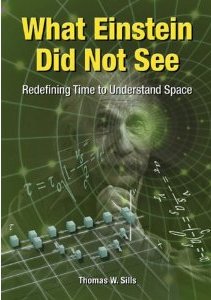Prof. Thomas W. Sills (Books)
by Thomas W. Sills
Pages: 138
Publisher: Dearborn Resources
Year: 2009
ISBN: 0964409631
ISBN: 978-0964409637
Websites: www.youtube.com/watch?v=plQ4wrZvGlI
Pages: 138
Publisher: Dearborn Resources
Year: 2009
ISBN: 0964409631
ISBN: 978-0964409637
Websites: www.youtube.com/watch?v=plQ4wrZvGlI
Today physics sees time and space as two words that seem to defy
definition. One unique definition for each of these words will not help
to describe the complex nature of time and space. Further, definitions
for time and space require more than seeing how they interrelate with
each other.
One uses different mathematical geometries to describe space. Understanding these different geometries provides a better approach to defining both time and space. In the seventeenth century, Euclidean geometry limited Isaac Newton to a three-dimensional space. Two parallel lines will never merge epitomizes Euclidean geometry.
In the nineteenth century new geometry evolved. Sometimes called non-Euclidean, or Riemann geometry, this new geometry applies to space with more than three dimensions. Einstein used this geometry in his theory of general relativity. Two parallel lines will merge epitomizes non-Euclidean geometry.
This book presents a new approach to both time and space. For the first time, readers will see how Euclidean geometry can describe space with more than three dimensions. This new approach redefines time into two different components: a vector of Timespace and a scalar of Universal Time.
Amazing insights result from this new approach. Three-dimensional projections from four-dimensional Euclidean space can now visually illustrate time travel. Contraction of Timespace, the fourth physical dimension, becomes equivalent to Einstein?s time dilation. General knowledge of Euclidean geometry allows the reader to understand the complex nature of higher dimensions in a new way.
Readers enjoy a friendly, informative walk into four, and higher, dimensions of space. New ideas in this book revise conventional physics. These ideas transform the three-dimensional world of conventional physics into a four-dimensional physical world.
One uses different mathematical geometries to describe space. Understanding these different geometries provides a better approach to defining both time and space. In the seventeenth century, Euclidean geometry limited Isaac Newton to a three-dimensional space. Two parallel lines will never merge epitomizes Euclidean geometry.
In the nineteenth century new geometry evolved. Sometimes called non-Euclidean, or Riemann geometry, this new geometry applies to space with more than three dimensions. Einstein used this geometry in his theory of general relativity. Two parallel lines will merge epitomizes non-Euclidean geometry.
This book presents a new approach to both time and space. For the first time, readers will see how Euclidean geometry can describe space with more than three dimensions. This new approach redefines time into two different components: a vector of Timespace and a scalar of Universal Time.
Amazing insights result from this new approach. Three-dimensional projections from four-dimensional Euclidean space can now visually illustrate time travel. Contraction of Timespace, the fourth physical dimension, becomes equivalent to Einstein?s time dilation. General knowledge of Euclidean geometry allows the reader to understand the complex nature of higher dimensions in a new way.
Readers enjoy a friendly, informative walk into four, and higher, dimensions of space. New ideas in this book revise conventional physics. These ideas transform the three-dimensional world of conventional physics into a four-dimensional physical world.



